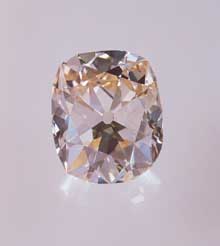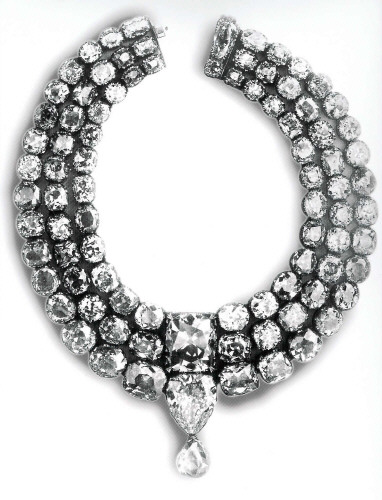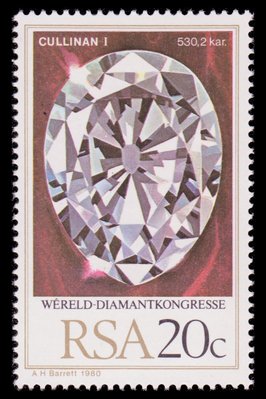The Star Diamond of South
| History of the Star Diamond Of The South.
Lying west of the mountains of San do Espinoza is a vast plain. Here the river Velma has its source, and the New World's largest diamond its origin. It was picked up in July, 1853, by a Negress at work in the mines of the province of Mines-Geraes, Brazil.
The diamond, when found, presented the general form of a rhombic dodecahedron with very obtuse angles, and twenty-four natural facets, besides certain faint streaks, pointing at a possible octahedral cleavage. In one of the facets there appeared a somewhat deep depression, in which was formerly inserted an octahedral crystal, which from other symptoms, was evidently a true diamond. On the lower surface were two other indentations of a similar character, but not so deep, one of which revealed traces of from three to four different crystals. On the same side was a flat space, where it had probably been removed from the matrix by alluvial action. There were also perceptible a few black specks, due apparently to the presence of titanic iron or volcanic sand. All these circumstances showed plainly enough that it originally formed one of a group of adamant crystals, fixed in the crevices of certain metamorphic rocks, characteristic of the Brazilian mountain systems.
Such, at least, is the commonly accepted view. But it is unhesitatingly rejected by Bar bot, who has made a special study of this gem, and whose opinion is certainly entitled to consideration. "We are certain," he writes, "that this large hollow was merely a solution of continuity in the crystalline layers, and that the other depressions of a slighter character are due to the same cause. The flat part, which seems and really is cleaved by an accidental cause, formed the point of contact with the matrix." The late M. Dufrenoy supposed that this diamond must have formed part of a group of diamantiferous crystals. In this he was mistaken, for diamonds are produced isolated, in the various parts of the matrix, rarely agglomerated or superimposed, nor grafted one on the other, like the pyrites and crystals of spar and quartz.
This stone which, according to the usual method of valuation, ought to be worth nearly pound 44,000, was sold in the rough for pound 35,000 and reduced by cutting from 254 1/2 to 125 carats, at an expenditure of close upon pound 500. In the process it assumed an elegant oval form, in which the light is well refracted. It is of unusual length, 35 millimeters by 29 millimeters broad, and 19 in thickness. These measurements, as Bar bot remarks, might seem to imply a magnitude superior even to that of the "Regent." Yet this gem is really 13 carats lighter, a fact explained by the perfect harmony of proportions exhibited by the "Regent," and which are missing in the "Star of the South." Nevertheless, it is a pure stone and has, on the whole, been handled with great judgment, although the best possible advantage has not perhaps, been taken of its natural forms. The cutter was Orangery, of Mr. Cortes's establishment at Amsterdam, and in his hands the diamond lost rather more than half of its original weight. The reflected light is perfectly white, but, strange to say, it assumes by refraction a decided rose tint, very agreeable to the eye. This probably unique phenomenon is due, no doubt, to the peculiar prismatic form imparted to the crystal, perhaps unconsciously, by the cutter.
After its latent beauties were thus revealed to the world, this superb gem was purchased by Mess rs. Halphen, and a few other merchants in Paris, who had constituted themselves a syndicate for the purpose. By them it was named the "Estrella do Sud," or "Star of the South." Before reaching them, it had passed in its rough state through several hands, all of whom were more or less benefited by its possession. Thus, the Negress, by whom it was discovered in 1853, was rewarded, according to the usual practice in Brazil, with her freedom, and to this was afterward added the further boon of a pension for life, in recognition of the exceptional size and value of her "find." Yet her master, Casimiro de Tal, was at first so little conscious of its true value, that he was induced to part with it for the relatively nominal sum of pound 3,000. The purchaser deposited it in the Bank of Rio de Janeiro, receiving an advance of no less than pound 30,000 on its security alone.
The stone ultimately reached the above-mentioned Paris Syndicate, by whom it was shown in the Dutch department of the London Exhibition of 1862, and in that of Paris in 1867. On both occasions it attracted great attention, and its fame reached the remotest corners of the globe. It was soon afterwards forwarded to India, where a bid of pound 110,000 was made for it by a large house on behalf of a native rajah. After considerable negotiation, the parties being unable to agree on the terms, the transaction fell through, and the stone was returned to Messrs. Halphen, who acted throughout in the name of the Syndicate, and not on their own account as is usually supposed.
During the exhibition of the gem in India, glowing accounts of its rare size and beauty had reached the late ex-Gaikwar of Baroda, next to the eccentric Charles, Duke of Brunswick, the greatest diamond fancier of modern times. This prince gave a commission, which was ultimately entrusted to Mr. E. Dresden, of London and Paris, to buy the Star of the South for eight lachs of rupees, or pound 80,000, Mr. Dresden, thereupon, applied through Mr. Halphen, to the Syndicate, who, although they had already declined pound 110,000, after some poulterers were induced to accept the Gaikwar's offer. On this subject we were favored on June 14, 1881, with a communication from Mr. Dresden, the subjoined extract from which will be found peculiarly interesting:
"A few years after the death of the late Emperor Napoleon, his Empress sold through Smith, Fleming and Co., her famous collection of diamonds (amongst which were a pair of splendid drops), to that same ruler of Baroda, so that he now possesses a matchless quantity of diamonds, including the Star of the South, which I had the commission to buy, and for which I paid Halphen in Paris two million francs (pound 80,000), inclusive, of course, of the mountings, &c., which were very costly."
I Having tried a similar expedient to get rid of the British resident, Colonel Phayre, whose presence in Baroda acted as an inconvenient check on his sanguinary propensities, the Gaikwar was arraigned before a specially constituted tribunal, found guilty, and deposed from the throne of his ancestors by a mandate from the beneficent lady paramount of India. | |

Star of The South Diamond
The 128.48-carat Star of the South is one of the world's most famous diamonds. Discovered in 1853, it became the first Brazilian diamond to receive international acclaim. The stone was graded as VS-2 in clarity and Fancy Light Pinkish-Brown in color. It was also determined to be a type IIa diamond.
It was the custom in the Bagagem Diamond Mines in Brazil for a slave worker who found a stone of mentionable size to be rewarded with his freedom which offered him the opportunity to work for a salary. In addition he might be given clothes, tools and in some cases a procession in his honor and during the ceremony might be crowned with flowers. All depending on the value of the stone found. This was done to encourage honesty amoung the workers. There were also several punishments established for those who were caught smuggling diamonds out.
In 1853 a slave woman while working in the mine discovered a 261.88-carat diamond. For this she was reward not only her freedom but in addition a life income. Yet apparently not aware of its true value, her master was induced to sell it for the modest sum of £3000, after which the purchaser disposed of it in Rio de Janeiro for $30,000.
The rough stone passed through many hands before it was sold to Costers of Amsterdam for $35,000 and cut to a 128.48-carat stone losing over half its original weight. The cutting cost was $2500. It was cut into a cushion-shaped stone with a faint pinkish-brown hue.
It was purchased by Halphen & Associates of Paris and was given the name the Star of the South. They displayed the stone at the London Exhibition in 1862, and in Paris in 1867 making it quite famous. At this time, the syndicate was offered £110,000 by an unknown Indian rajah, but the offer was declined. Later, for reasons not divulged, it was sold to Mulhar Rao, the Gaekwar of Baroda, for £80,000, or about $400,000.

in 1948, Sita Devi, the Maharani wearing a star diamond of south neckless
The Gaekwar gave the commission for this transaction to E.H. Dresden, who made the original purchase of the well-known English Dresden Diamond. In 1934, the potentate's son told Robert M. Shipley, the American gemologist, that both the Star of the South and the English Dresden were mounted in a necklace among his family's jewels.

Khande Roe, Gaekwar of Baroda, had this necklace made to display both the
Star of the South and the 78.5-carat English Dresden below it.

